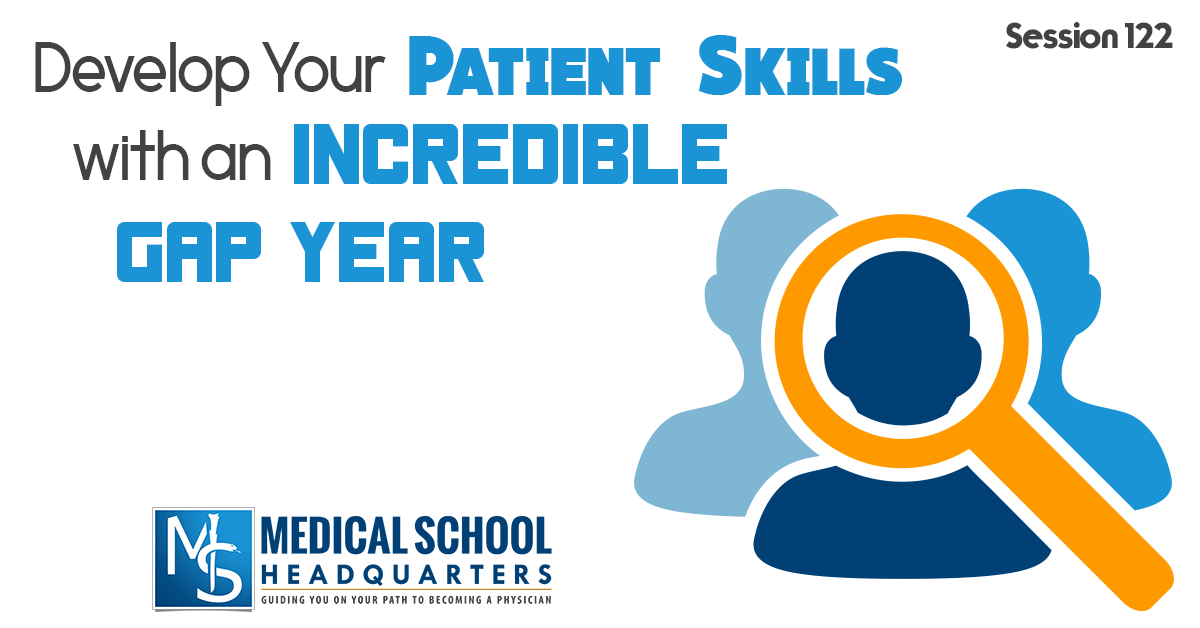
On top of this, they are also creating a curriculum about patients’ experiences with health and health care. They’re in the business of not only helping patients but health care providers and everyone involved in health care. They offer premed students a gap year opportunity to get a real experience interacting with patients.
Listen to this podcast episode with the player above, or keep reading for the highlights and takeaway points.
A gap year is a year between undergrad and medical school. I’m a huge believer in gap years, especially if you use it to get more clinical experience, because it helps you become more empathetic with patients. Clinical experience helps you understand what life is like for a lot of patients since you will be working all day, not on student’s schedule.
In short, gap years are beneficial. They give you the experience of what it’s really like to live in the world outside of being a student. Additionally, any jobs you have can add to the experiences you can list on your application.
Gap years give you the experience of what it’s really like to live in the world outside of being a student.Click To TweetThere was an article in The Harvard Crimson about Students Taking Time Off Before Applying to Medical School.
Robert Mayer, the faculty associate dean of admissions at Harvard Medical School, talked about how he’s been there for 11 years. He noted that when he started, 60% of matriculating medical students came straight out of college (traditional students).
65% of students starting medical school today have taken some time off before started medical school.Click To TweetEleven years later, that number has decreased to about 35%. Hence, 65% of students starting medical school today have taken some time off before started medical school.
[Related episode: What Jobs Should I Do During My Gap Year?]
Clinical experiences with different social and cultural groups can enrich your ability to score on the social sciences on the MCAT since it’s been changed in 2015.
[Related episode: Should I Take Sociology to Prepare for the MCAT?]
Advocating for Populations: a 4-week highly intensive course learning about advocacy in media, legislature, community, etc.
Advocating for Patients: a quick and dirty course about the health care system, clinician’s role, how to be an effective and efficient advocate, and developing an advocacy infrastructure in your practice
They have a class starting in the summer if you want to get started right away. Classes start on Tuesday, May 26, 2015. Classes in Fall start the day after Labor Day.
[Related episode: What Are Some Good Gap Year Ideas?]
To be an advocate for a patient will expose you to so many things you’ll never have exposure to as you’re going through medical school or residency. Take the time to learn about this opportunity. In the end, it will make you more informed and it will definitely improve your patient outcomes.
To be an advocate for a patient will expose you to so many things you'll never have exposure to as you're going through medical school or residency.Click To Tweet
Lorem ipsum dolor sit amet, consectetur adipiscing elit
I just received my admission to XXXXX! This is unreal and almost feels like I am dreaming. I want to thank you for all of your help with my application. I cannot overstate how influential your guidance and insight have been with this result and I am eternally grateful for your support!
IM SO HAPPY!!!! THANK YOU SO MUCH FOR ALL YOUR HELP, IM INDEBTED TO YOU! Truly, thank you so much for all your help. Thank you doesnt do enough.
I want to take a few moments and thank you for all of your very instructive, kind and consistent feedback and support through my applications and it is your wishes, feedback, and most importantly your blessings that have landed me the acceptance!
I got into XXXXX this morning!!!! It still has not hit me that I will be a doctor now!! Thank you for all your help, your words and motivation have brought me to this point.
I wanted to once again express my heartfelt gratitude for your help in providing feedback during my secondary applications. Your guidance has been instrumental in my journey.
Just wanted to share my wonderful news! I received my first medical school acceptance! Thank you for all that you do for us Application Academy!!!
I am excited to tell you that I just got my third interview invite from XXXXX today! I can’t believe it. I didn’t even know if I was good enough to get one, let alone three – by mid-September. Thank you so much for all of your help and support up to this point; I would not be in this position without it!!
I wanted to thank you for helping me prepare for my XXXXX interview. Even in a 30-minute advising session, I learned so much from you. Thank you for believing in me, and here’s to another potential success story from one of your advisees!
I just received an acceptance with XXXXX! This is so exciting and such a huge relief and so nice to have one of our top choice schools! I also received an interview with XXXXX which brings the total up to 20 interviews! Thank so much, none of this would have been possible without you!

Join our newsletter to stay up to date
* By subscribing you agree to with our Privacy Policy and provide consent to receive updates from our company.
Resources
Advising Services
Podcasts & Youtube
Books
About
"*" indicates required fields